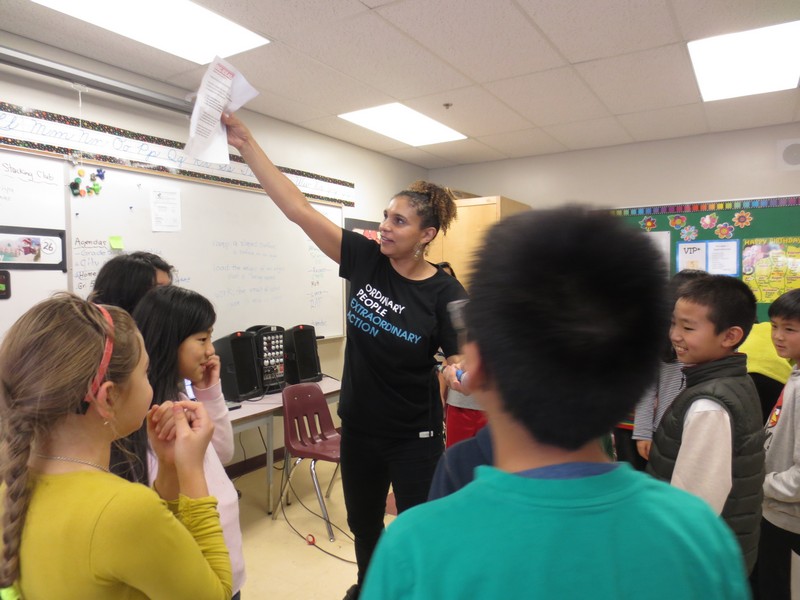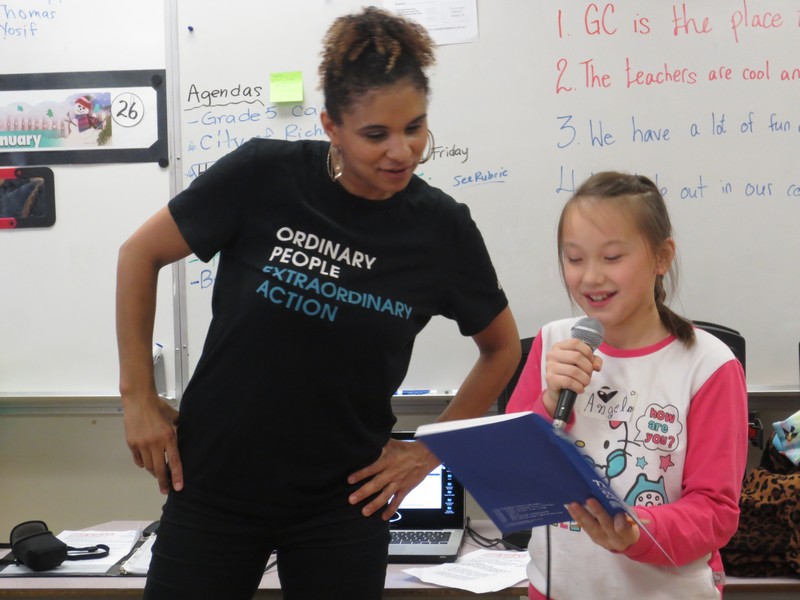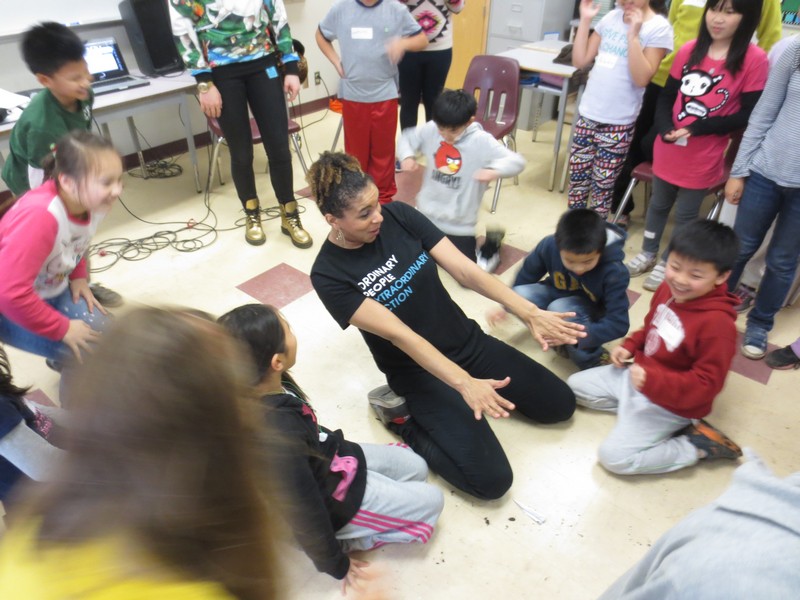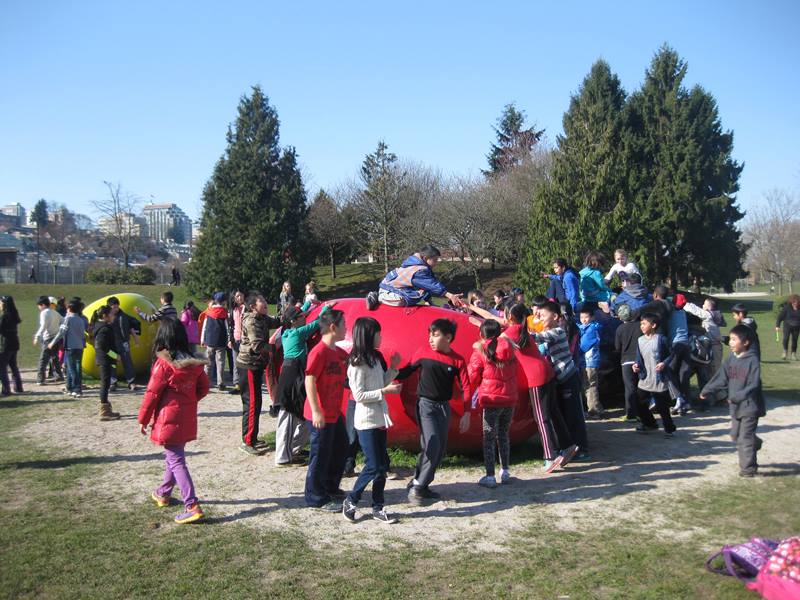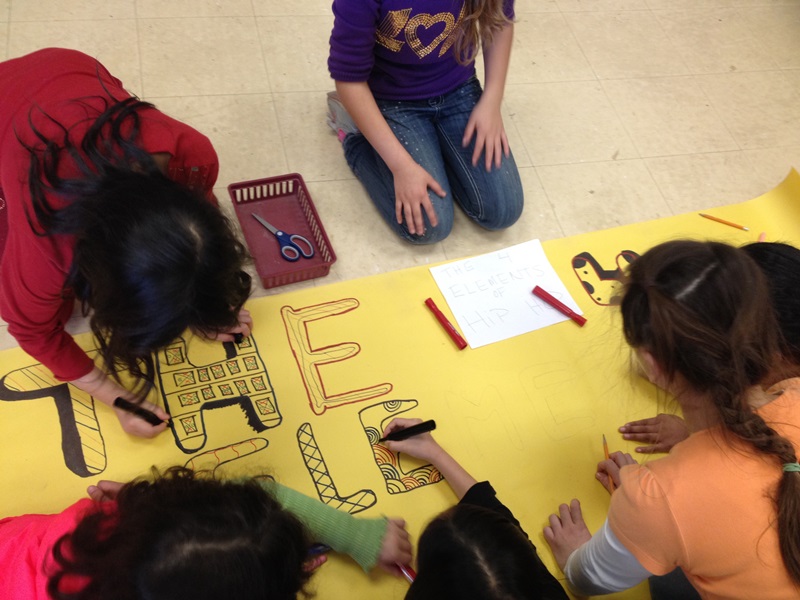General Currie Elementary: Cooperation or Competition
Arts Education, Health and Career Education, Language Arts, Physical Education, Social Studies
School: General Currie Elementary, Richmond
Teacher: Sara Mais, Carolyn Russo, Tristan Taylor
Artist Collaborators: Kia Kadiri
Class: Grade 4/5
Overview
This project examined how humans impact one another, and how our interactions can be cooperative, or competitive, or both. This project addresses both the current grade 4 social studies curriculum, and the redesigned grade 5 social studies curriculum by exploring how colonizing populations and Aboriginal populations interacted with one another from the point of first contact, and how a common desire for resources resulted in conflict over centuries. Students inquired into how, as heirs of colonialism, we can nurture a relationship that was scarred by past events, and how art can offer entrance into reconciliation.
Connection to the Vancouver Biennale Exhibition
Students visited the following Biennale exhibitions:
Human Structures Vancouver: to talk about how the lives of individuals are interwoven, and how we can build upon one another’s strengths to create something stronger, and greater.
Giants: to talk about human possibility, and how together we can do amazing things, side by side in cooperation.
Love your Beans: to talk about diversity, and celebrating diversity in art and in life, enjoying difference, rather than trying to assimilate it.
This project strives to help students understand the barriers to relationship that were created by colonization, and how these borders can be broken down through understanding, and commitment to change for the better.
BIG IDEAS
Our coexistence as human beings means that our lives are interwoven, and thus, that our actions reach far beyond ourselves. The coexistence of humans requires us to interact with one another in different ways, sometimes cooperatively, sometimes competitively. Our past interactions with Indigenous people impact our present connections.
Human expression in the arts can connect our individual experiences to the experiences of others, and can create opportunities for learning and positive relationships.
Guiding Questions
How do people express their connectivity to others, and move their relationship forward?
How can we build cooperation from diverse, and sometimes difficult histories, and present day circumstances?
Cross-Curricular Access
• Arts Education: Students expressed and connected their individual experiences to the experiences of others through words, dance, art, and music.
• English Language Arts: Student maintained a journal in which they would write down raps on cooperation and competition. The rap journals were assembled to create the final project rap song and individual poetry in different languages.
• Physical and Health Education: In games and discussion, students explored how to build positive relationships in real life situations using the following guiding questions: What are the benefits of cooperation? What are the benefits of competition? What is done in the world through cooperation? What in the world results from competition? Do you personally like cooperating? Do you like competing, Can you enjoy doing both?
Social Studies: Students researched the colonization of Canada, and examined the impacts of colonization on Aboriginal societies. They explored what different views colonizers and Indigenous populations had about land and resources. Students learned to show respect of each other’s cultures and begin to think about how can we move forward together in a reconciled relationship after colonization.
Learning Process/Inquiry Challenges
• Students studied the history of their local community, and make connections between the Indigenous population that existed here, and what life is like today in this place.
• Students researched the colonization of Canada, and examined the impacts of colonization on Aboriginal societies. Students explored what Canada looked like before colonization and mapped out the diverse Indigenous populations that existed in Canada.
• Students studied who arrived here, and for what purpose. They explored what different views colonizers and Indigenous populations had about land and resources, how competition for land and resources affected the relationship between Canadian and Aboriginal peoples during colonization, what was shared between the two populations, and if any cooperation happened between the two groups?
• Students examined how the colonization of Canada has impacted current relationships between Indigenous populations and the rest of Canada, and begin to think about how can we move forward together in a reconciled relationship after colonization.
• Students explored what types of expression could help reconcile and connect people, and think about how art can help that process. Students could engage in a Project of Heart activity where they make tiles, or another art piece of apology for survivors of Residential School.
• Students paid visit to the Interweavings exhibit at the Richmond Art Gallery, and explored Indigenous art. Students think about what artists learned in the process of creating art across generations. What can be learned from this art? How can we learn from elders and the past to make the future better?
• Using music, movement and interactive games, students learned how to rap; and collaborate on a song that expressed their collective voice on the topics of cooperation and competition and ways of showing respect, cultural appreciation, and acknowledging our differences. The final project performance built upon the ideas of building relationships and reconciliation.
• The project focused on nine learning concepts:
- Pride: Be proud of where you come from
- Creativity: Express your feelings with words, dance, art, and music
- Respect: Respect each others cultures
- Take Risk: Try New Things
- Learn from Our Mistakes: Learn about our history and learn from our mistakes
- Each One Teach One: Share your knowledge and teach each other
- Cooperation: Work together to solve problems
- Unity: Try to make our community a safe, fun place
- Expressing through Arts: Music, Poetry & Words, Art, Dance – The 4 elements of Hip Hop – the DJ, the MC, Graffiti, and Breakdance
Poetry and Lyric Writing: the students worked independently and in teams to write poetry/ lyrics that was to be incorporated into a group and individual raps in different languages. Every student maintained a journal in which they would write down raps on cooperation and competition. The artist and the teacher jointly facilitated warm-up and brainstorming activities to foster the students’ imagination and ideas to write down their thoughts, in the form of poetry in their rap journal. This resulted in students pushing their boundaries of imagination and language skills. They wrote poetry in their own native language and translated verses from English to their native language. The writings were assembled to create the final project rap song and individual poetry in different languages like Cantonese, Mandarin, Russian, etc. The selected verses were set to music through collaboration of the artist and teachers. Through the poetry writing process, students celebrated diversity and developed appreciation of different cultures and languages. This spirit of respect and cooperation continued throughout the project.
Choreography and Dance: The students learned group dance routines to be performed along with their rap during the final performance. Each student assumed a different role in the dance formation and routine and through this the students practiced values of team building, teamwork and cooperation. The students also danced to the choreography for the popular number Uptown Funk, which was performed along with the teachers with feature solo performances. The choreography and practice sessions instilled confidence and team building skills in the students.
Song Recording: After writing the lyrics and poetry and setting it into music, the entire song sequence and recitation of poetry was recorded to be played during the final performance. It was exciting for the students to learn and experience the recording process and gave them an understanding of the entire creative process of music production. This was facilitated by the artist and a guest artist, Russ Klyne, the recording engineer.
Field trip to Biennale Open Air Museum: During their visit to Human Structures Vancouver, Love Your Beans and Giants, the students formed connections between the human figures configuration of Giants and Human Structures Vancouver with the notion of cooperation and their inquiry process through questions in the art-inquiry worksheet. Their responses were shared and inspired the creation of the art banners for the final performance.
Banner art: The students created art banners to highlight the nine key project learning concepts: pride, creativity, respect, risk taking, learn from our mistakes, each one teach one, cooperation, unity and expressing through the arts. These banners were presented at the start of the final performance to convey the project learning objectives.
Rehearsal: During the rehearsal, the artist discussed aspects of stage presence, positions, flow and also addressed the issue of stage fright, giving the students confidence.
Final performance: On March 13, 2015, the students of Grade 4/5 performed their final show which incorporated poetry, rap, dance, music and art. This was attended by the entire school and the parents. After the students completed their performance, the artist invited all the members of the audience to participate and follow simple dance movements to the song Paint the Sky, living up to and practicing cooperation in every sense!
Student Creation
Poetry and group song lyrics
Dance
Performance incorporating poetry, rap, dance, art, and music
Timeline
January
Intro to rap artist workshop
Student wrote poetry on cooperation & lyrics for group song
February
Student learnt about dance movements. Students practiced team building skills, together and in small groups (COOPERATION)
Students worked on dance skills
Students put movement together with the lyrics from the Group Song for the performance piece.
Students practiced the raps in different languages
Student begin to build the show facilitated by the artist and teachers
Students recorded the group song for the performance
Students reflected on the project key learning points and work in groups to create art banners to highlight nine learning concepts
March
Student took fieldtrip to Humans, Giants, Beans, Friendship Center
Students rehearsed for the performance
Final Performance and Presentation to the entire school and parents
Reflection
Teachers – Sara Mais, Carolyn Russo and Tristan Taylor
Over the past 8 weeks we have had the pleasure of working with the Vancouver Biennale. The overall experience has been overwhelmingly positive. Our Biennale artist, Kia Kadiri, instantly recognized the rich diversity our school has and she was able to create an experience for students that was inclusive and engaging. Her commitment to making sure that every student was included during each session meant that all students had fun during this learning process.
During the time working with our school, Kia was very approachable and available for collaboration with us as we worked together on a constantly evolving and changing exploration through inquiry. Students were drawn to Kia’s natural charisma and her interactions with the children were genuine and earnest. She also brought in a handful of guests that each had their own unique skill or ability which enriched the experience for the children.
Our field trip visiting the outdoor Biennale installations were thoroughly enjoyed by staff and students alike; the pieces we visited engendered different interpretations that covered conflict and competition just as we had planned. The Giants structures in particular left some students envisioning an optimistic future of standing on the shoulders of giants and building upon that. Juxtaposed with that, others felt the structures were cold monoliths towering over them, hindering and controlling them.
Our experience with the Biennale culminated with a live performance in front of the entire school and parents. The audience was impressed and entertained by the amazing mix of rap, break dancing and art. We are thankful for our experience with the Biennale and look forward to working with them in the future.
Students
“It was such a fun opportunity to perform after all our hard work, and to bring our rapping inside out. We love the words and phrases on our banners. It was awesome having that experience.” Angel
“Up until now I didn’t really like talking in front of people, I wasn’t really confident and felt shy around other people, but rapping with Kia changed that. I learned a lot about appreciating our different cultures. No one really judged me because everyone was accepting of who I was and just let me be me.” Ethan
“Thanks to you my boost of confidence has just levelled up and my long time stage fright finally went away.” Nicole
“I got a chance to share my culture. Thank you for teaching us to rap and letting us rap in different languages. It finally gave me a chance to have fun with Chinese! Yeah!” Edward
“I had a fun time, even on grumpy days.” Joshua
“The best part was looking at the art installations and the colours and the details. I noticed the sculpture were connected in some sort of way, like when we were discussing about cooperation, helping each other and working together. Thanks for teaching us how to rap and for putting our performance together. This experience has been awesome and fun.” Jennifer
Artist -Kia Kadri
I had the pleasure of working with 3 classes (all grades 4 & 5), and their amazing teachers, Sara Mais, Carolyn Russo and Tristan Taylor. The teachers were very supportive and engaged with the students during the entire 8 weeks that I worked with them. Together we decided that it would be best for me to work with all 3 classes once a week. I created an 8-session program that included art, dance, rap, writing and several special guests.
The staff presented me with an art book that the youth created, as a thank you gift. It was one of the most special gifts I’ve ever received. Each child drew a picture at the top portion of the page, and wrote a few words on the bottom portion. Some of the best compliments were from kids who, thanked me for helping them to not be so shy, and for helping them overcome stage fright, and become more confident Many of the teachers and parents were very pleased with the way I was able to showcase the youth rapping in different languages, and the way I was able to include the youth with different disabilities in the performance.
“Kia, Thank you for bringing hip hop and rap into our lives! We all learned a lot and had so much FUN doing it! It’s obvious you are passionate about what you do – and your enthusiasm is contagious. You have helped to make “G.C.” a better (and way cooler) place to be!” – Sara Mais (lead teacher on the project)
I wanted to really offer the best experience to the youth, and so I relied on some of my talented friends to assist me as special guests. I think that it enhanced the experience for the youth. The guests included:
Claire Mortifee – Musician, Songwriter – assisted us with writing raps in different languages
Cassandra Onyejikwe – Dance instructor – Choreographed our Dance, supported the final show
Russ Klyne – Musician, Producer – Recorded our group song, produced the final recording
Colin Trickey – Break-dancer – Feature performer during our final show, taught youth after show
Trevor Venos – Videographer – Filmed our entire last day, dress rehearsal & final performance
I had a lot of fun during this project, and I look forward to working with the Vancouver Biennale in the future.
